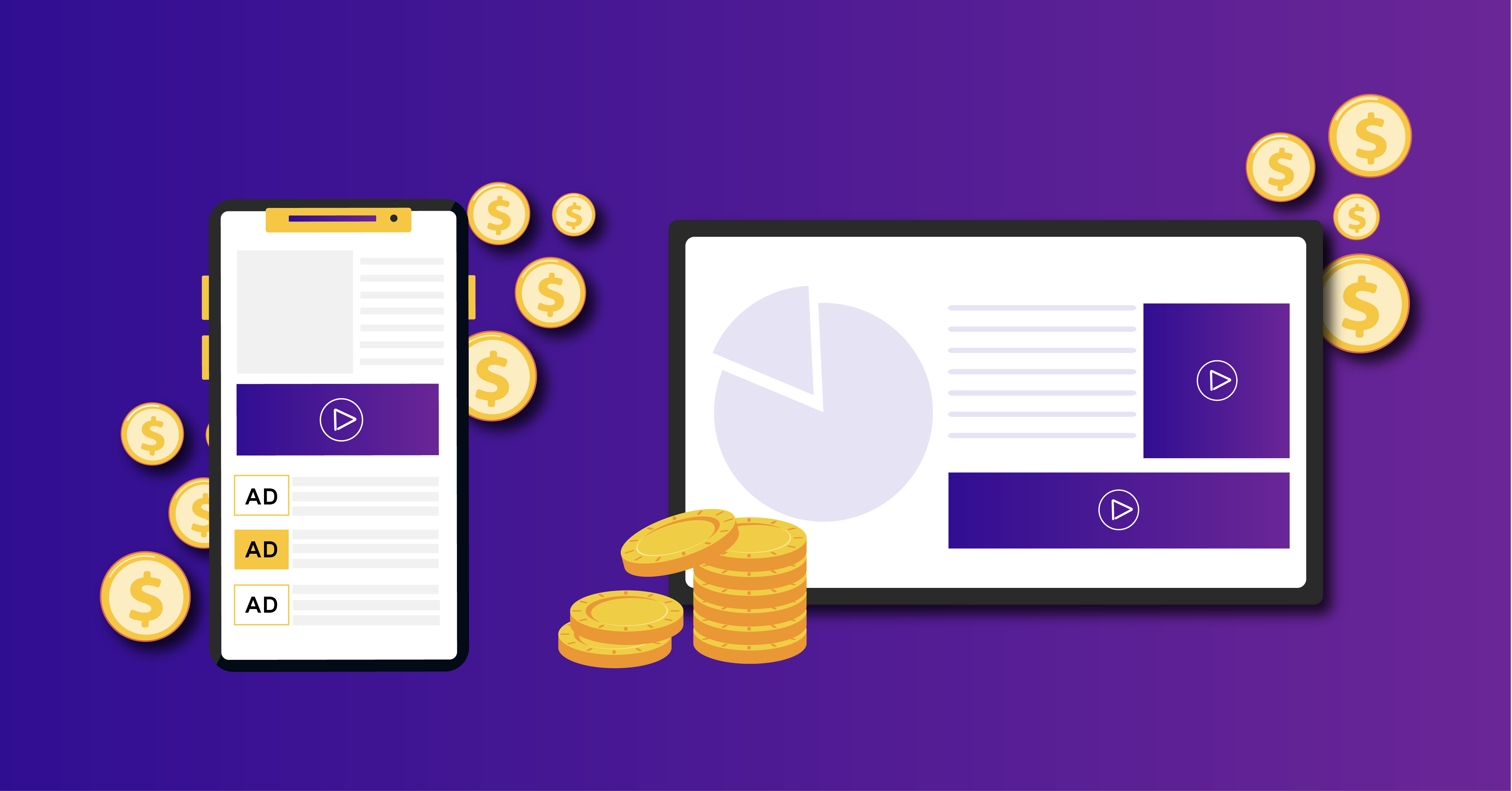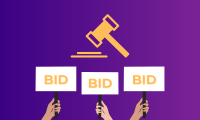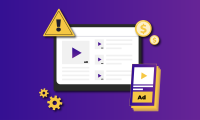2023 Monetization Strategies: A Guide For Publishers
Web and app monetization are valuable means of capitalizing on emerging trends and responding to the evolving needs of consumers. The rising popularity of web and app monetization is a result of an increase in internet and mobile usage, snackable content, technological advancement, and changing consumer behavior. By monetizing these two platforms, publishers can provide a value proposition to their users and amplify their holistic revenue.
Publishers need varied website and app monetization strategies to juice the most out of each property.
Top 7 Mobile App Monetization Strategies For 2023
- Leverage in-app advertising
The key to successful in-app advertising is adding value to the user’s time. Apps help boost engagement, user base, and revenue. To leverage in-app advertising to its optimum potential, publishers must keep the ads non-intrusive, cohesive to brand identity, and contextual. By experimenting with ad formats and optimizing ad placements, publishers can create the most yielding campaigns.
- Adopt the in-app purchases model
In-app purchases are one of the most common app monetization models. An estimated 50% of non-game and 79% of game apps use it. This monetization strategy accounts for 48.2% of mobile app earnings as compared to 14% from ads-based revenue and 37.8% from paid app downloads. This model is efficient for publishers and content creators from varied niches such as gaming, education, self-help, news, etc. This strategy helps publishers in generating recurring revenue, increase user retention, build direct relationships with users, and get intricate insights into user preferences and shopping behavior.
- Look for sponsorship and partnership
Sponsorships and paid partnerships are popular app monetization strategies that do not rely on ads or purchases for revenue. This strategy is ideal for cross-promotion across different platforms of publishers as well as sponsors. Besides monetary advantages, sponsorships can help app content creators in community building, increasing brand awareness, and engagement. To reap these benefits, publishers must gain partnerships that are relevant to their audience, app content, and niche.
- Earn with licensing
Licensing is an app monetization method that relies highly on user data and is community-driven. Through this strategy, publishers do not charge their app users but the businesses that want to use their app data or platform to run ads. Publishers must have high traffic and data segmentation based on demographics, geography, and consumer behavior to extract the most value from the licensing model.
- Use interstitial ads to grow eCPM
Advertisers are ditching the standard ad formats and leaning towards this coming-of-age ad format that is interstitial ads. This ad format has spiked the CTR (click-through rate) and eCPM (effective cost per thousand impressions) manifold making it an ideal part of app monetization strategy for publishers. Interstitial ads take up the whole screen of the host app and hence, they generate high viewability and engagement. To make the most of this ad format, publishers must display them at natural transition points such as at the end of a level in a game or at the end of a task.
- Use native ads to improve CTR
Native ads are prominent for being non-disruptive to user experience. A successful native ad is one that blends coherently with the UI components of the host platform. Since they are non-intrusive and co-exist with the app content and design, they are likely to deliver high CTR. To actively make this ad format more efficient, publishers must set a desired CTR and create KPIs to achieve the same. Live tracking campaigns and optimization as per performance can help hit and exceed the expected CTR.
- Freemium subscriptions
With the freemium subscription-based model, app publishers have the control to turn users into subscribers. The freemium model attracts a high number of users. If they are appealed by the content, they will upgrade to the paid subscription to access the exclusive content. This app monetization model offers increased opportunities for user acquisition, upselling, driving traffic, and user base. But publishers must ensure to balance the value added by the freemium and premium content. If the former is overvalued, they may lose premium customers.
Top 7 Website Monetization Strategies For 2023
- Experiment with affiliate marketing
Affiliation can be considered a long-term, passive income source for publishers. It is also known as a low-risk, high-return web monetization method. Publishers make money on commissions as and when a purchase is made by their readers through their affiliate link. Credibility and transparency play vital roles in the success of affiliate marketing. Publishers must always recommend products with sincerity and honesty. At the same time, they must disclose their affiliations to their audience.
- Start a paid membership website
Paid memberships fuel revenue as well as the user experience. Publishers have complete control over what they bring to the table and what value they add to their subscriber’s money. Through this monetization method, publishers can offer exclusive content, discounts on their online products or services, and other perks in exchange for a recurring fee. To make the most of this web monetization method, publishers must offer value-based pricing and build a tier-based subscription model.
- Monetize access to your email list
With the rise in first-party data collection, publishers today have access to diverse data. They can sell this data i.e the subscriber’s email details to other businesses. This data is the key to building personalized campaigns, easy lead generation, and consumer insights for multiple businesses. However, publishers must get approval from their users for distributing their data.
- Publish sponsored posts and product reviews
Sponsored content is a secure and steady income source for publishers. By posting relevant sponsored posts and product reviews, publishers elevate the significance of their user’s time on their websites. Furthermore, they are exposing their audience to novel brands and products. This boosts brand awareness, website traffic, and clicks, and helps the publishers to build a community.
- Gated content
Creating gated content means building a walled garden that restricts content access but amplifies its value to consumers. In the cookie-less world, the walled garden is one of the most coveted upcoming ad tech trends. Publishers get the freedom to create uncensored and personalized content. They also get access to first-hand data that can be further used for programmatic advertising to generate ad revenue.
- Accept donations
Earning from donations is one of the most ubiquitous revenue generation methods amongst content creators and publishers. They can collect donations through their own website or use platforms like Patreon, YouTube Live, Gumroad, Ko-fi, and Buy Me a Coffee. Publishers can ask for donations instead of a subscription fee in exchange for content. This is a community-building web monetization strategy. Transparency and communication can help publishers generate donations from their readers, users, or followers to continue to create- high-quality content for them. However, publishers must convey this message to their community.
- Flip websites
Publishers who have sharp scrutiny for errors and expertise to resolve it can benefit from flipping websites. This business model involves publishers buying underperforming websites and upgrading them by flipping their designs, codes, and content, and then selling them for a higher price. Or, they can keep creating content for the website and generate ad revenue from it. Publishers can sell this website online or amongst their own networks. The success of this web monetization method depends on a combination of niche expertise, knowledge of SEO (search engine optimization), market awareness, and networking.
To generate revenue from web and app monetization, publishers must create top-notch content that appeals to a larger audience and build their online reputation through collaborations or sponsorships. Credibility and visibility are pivotal to generating multiple revenue streams. Diversified monetization strategies will help publishers maximize their content potential and hence, their revenue.




Leave a Reply